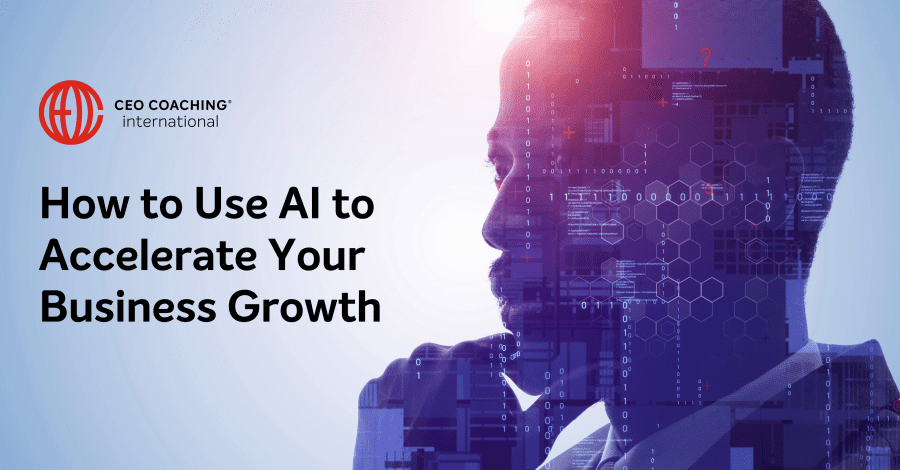
Increasingly, the world runs on artificial intelligence (AI) and machine learning (ML). Yet only 50% of companies who responded to a 2020 survey by McKinsey & Company said that they have adopted AI in at least one business function.
That looks like a pretty clear dividing line between companies that are going to struggle to keep pace with the rate of innovation and companies that are positioning themselves to succeed in our digital future. Use this three-step process to make sure that your company falls on the right side of that line.
1. Ask questions.
Even companies that have a small digital footprint are usually pretty good at capturing data. Where they struggle is asking effective questions about that data. Every time a customer makes a repeat purchase, every time a prospect clicks or doesn’t click on a marketing campaign, every message that gets typed into your customer service chat box is an opportunity for analysis. If you’re not taking those opportunities to ask questions, you’re never going to get answers that could accelerate your company’s growth.
Some good questions to ask about your data include:
- How can we maximize shareholder value?
- Are we exceeding customer expectations and inspiring loyalty?
- Is there an opportunity for a quality partnership that could maximize our operational effectiveness?
- Where are our products and services falling short? Where are they excelling?
- What are customers and potential customers looking for that we’re not yet offering? What’s next?
Finally, take the answers that you and your team arrive at and see how they fit in to the BIG goals that you established at your annual planning session. If you’re falling behind, your data should help to explain why. If you’ve been consistently hitting your weekly, monthly, and quarterly targets, your data could provide guidance on how to aim higher and achieve more before the end of the year.
2. Identify new opportunities for data collection, automation, and augmentation.
As your data leads you back to your annual goals, you should see areas where you could be casting a wider net or building out a more robust AI or ML infrastructure. Perhaps there’s a customer acquisition data point that you’ve been overlooking. Or, maybe there’s a routine customer service process that’s taking up too much of your team’s time and limiting how much high-touch service you’re able to provide.
Some common areas where AI and ML can improve operations across many industries are:
- Risk assessment
- Credit checks and underwriting
- Fraud detection
- Customer and employee onboarding
- Monitoring social media
- Predicting fluctuations in supply and demand
- Personalizing marketing campaigns
- Automating document completion
- Order validation
- Anomaly detection
- Speech and face recognition
- Translation and transcription
- Recommending additional products and services to customers
Again, it’s critical the potential improvements that you identify are directly connected to your goals. Investing in shiny new things like more data-gathering or smarter algorithms is useless if these investments aren’t going to keep moving the business forward. Ask yourself:
- Am I solving a problem, or buying a solution in search of a problem?
- What will the overall benefit be to my customers and employees?
- Would this project be a quick win, a long-term development, or a total transformation of how we do something?
- Do we have the budget and team members we need to utilize this technology properly?
3. Put your key employees first.
Looking at that list of AI and ML applications, you can probably identify a digital solution that would improve your customer service experience, speed up your cash flow cycle, or broaden your market reach. These are all key potential drivers of growth. But maintaining that growth is impossible if you don’t have the right people working for you. Many companies get so caught up in the growth opportunities that their data reveals that they go on indiscriminate hiring sprees, or overlook mediocre work from longtime employees. They sacrifice long-term quality and sustainability to chase short-term gains and trust the algorithms will sort out the rest.
As powerful as AI and ML are, they are still just assistants. On the ground floor of your company, you need customer-facing employees who leave the busy work to your AI so they can focus on providing outstanding human-to-human service. In the middle, you need leaders who use your data to identify inefficiencies but use their humanness to inspire their teams to come up with innovative solutions.
In your C-suite, it’s possible that you might need to add a new position: Chief AI Officer. As brilliant as your veteran CFO and COO are, modern digital data might be new to them. Many companies are starting to dedicate an executive chair to trained experts who can interpret all the nuances of the data they’re collecting and manage the implementation of new AI and ML processes. If you’re not ready to shake up your management structure, you could work with a “virtual CAIO” consultant or an entrepreneur coach with a background in AI who can help bring you and your team up to speed.
Ultimately, companies that are going to keep pace with these accelerating digital transformations won’t succeed because of how they collect data or how smart their algorithms are. The key differentiator will be the CEO. If you commit to data-based growth, it will be very difficult to argue with what your numbers are telling you. Following through on those conclusions requires the clear vision and decisive leadership that keeps the very best CEOs ahead of the curve.
***
Asha Saxena is a coach at CEO Coaching International. She’s a strategic, innovative CEO and Director with over 25 years of experience and a proven track record of building successful businesses. With a strong academic background, creative problem-solving skills, and an effective management style, Asha has been instrumental in building business models for success.
About CEO Coaching International
CEO Coaching International works with CEOs and their leadership teams to achieve extraordinary results quarter after quarter, year after year. Known globally for its success in coaching growth-focused entrepreneurs to meaningful exits, the firm has coached more than 1,500+ CEOs and entrepreneurs across 100+ industries and 60 countries. Its coaches—former CEOs, presidents, and executives—have led businesses ranging from startups to over $10 billion, driving double-digit sales and profit growth, many culminating in eight, nine, or ten-figure exits.
Companies that have worked with CEO Coaching International for two years or more have achieved an average revenue CAGR of 31% (2.6X the U.S. average) and an average EBITDA CAGR of 52.3% (more than 5X the U.S. average).
Discover how coaching can transform your leadership journey at ceocoachinginternational.com.
Learn more about executive coaching | Meet our world-class coaches





